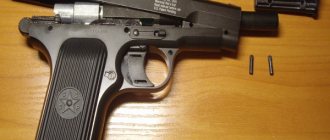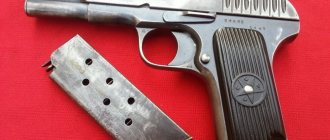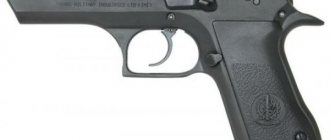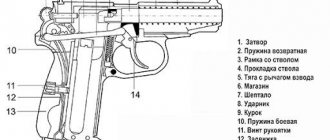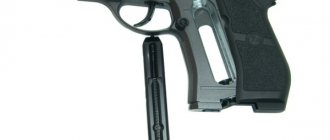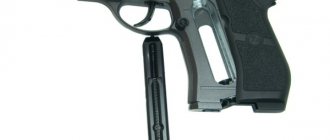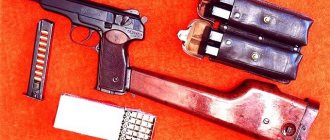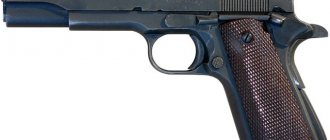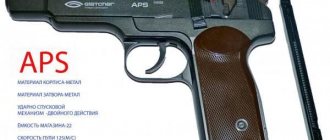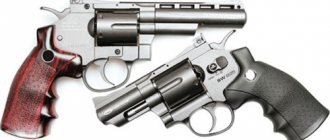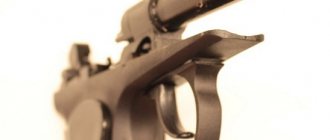Review of the Gletcher JRH 941 air pistol
The model is a copy of the Israeli combat pistol IMI (since 2005 - IWI) Jericho 941. Introduced in 1990, it was supplied as the main weapon for law enforcement agencies, and is still used today.
Visually, the pneumatic version is almost identical to the combat version. Among the differences: pneumatics do not have a blowback - the bolt is motionless, and the false skin does not carry a functional load, and is used only for similarity with the prototype.
The sound when fired is quite loud. The recoil is noticeable, but minimal: the barrel hardly moves upward, which is convenient when shooting in bursts.
Gas pistol - the energy of compressed gas is used to fire a shot. This option is good because it allows you to shoot in series without reloading (like spring-piston and PCP pneumatics). There is a limitation - the manufacturer does not recommend firing too quickly (no faster than 1 shot per 2 seconds).
The power of the Gletcher model is not too high: with a “fresh” cylinder at a distance of 9-10 meters, the bullet breaks a beer bottle, pierces right through 2 layers of not too thick cardboard, and bounces off a plywood sheet. At a greater distance (15-20 meters), the pistol is ineffective and can be used for sport shooting at a paper target in calm weather.
Accuracy at a distance of 8.5 meters from the target is not very good: the bullets fall in a circle with a diameter of about 5-6 cm. At a distance of 10-12 meters, this number increases to 6.5-7 cm on average.
Advantages and disadvantages
The advantages of Gletcher JRH 941 include:
- low cost (about 3500 rubles);
- large magazine capacity (21 bullets);
- economical consumption of CO2 (on average, 1 cylinder is enough for 80-100 shots);
- realism and similarity to the original.
The disadvantages include:
- immobility of the shutter (in the combat prototype the shutter is movable);
- inability to install laser target and optical sight;
- lack of ability to adjust the aiming bar.
The inability to install optics and a laser target designator cannot be considered a significant drawback - the power of the pistol still does not allow shooting at long distances, where such sighting elements are required.
The principle of operation (gas cylinder) can be attributed to both advantages and disadvantages. On the one hand, this allows you to fire quickly without having to reload with each shot. On the other hand, shooting requires periodically changing cylinders (while spring-piston pneumatics are autonomous).
Photo of the Gletcher JHR 941 air pistol
Purpose
The Gletcher JRH 941 can be used for recreational shooting. It can also be used for precision training at short distances.
The ability to fire in bursts and visual similarity to military weapons allow the pistol to be used for self-defense. A bullet can cause real damage to an opponent only if it hits the eye (which is dangerous, since it can be classified by the Criminal Code as exceeding self-defense measures) - so the effect on an opponent in case of danger can be rather psychological. It is more important to use a pistol to protect yourself from stray dogs.
Specifications
The technical characteristics of the Gletcher JRH 941 model are as follows:
| Characteristics | Indicators |
| Principle of operation | gas cylinder |
| Energy source | CO2 cylinder, 12 grams |
| Barrel type | threaded |
| Housing material | plastic |
| Store material | metal |
| Shutter material | metal |
| Length, mm | 220 |
| Weight, g | 900 |
| Ammunition type | steel explosive ball |
| Caliber, mm | 4,5 |
| Magazine capacity | 21 |
| Power, J | 3 |
| Initial bullet speed, m/s | 130 |
Device
The build quality of the pistol is high, but all the elements are made simply - you can immediately understand that this is an inexpensive model. The shutter is fixed, made of metal. There is a movable false skin: it moves during a shot, but does not perform any functions.
The sighting elements are the front sight (small, non-adjustable, without fiber threads) and the aiming rib (also not adjustable). The slot of the strip is narrow, and on the sides of it there are two white dots painted with paint.
Next to the bar there is a symmetrical double-sided flag fuse. In the lower position (“tongue” is set at an angle of 45 degrees relative to the floor), the pistol is on safety; in the upper position (“tongue” is parallel to the floor), it is ready to fire.
The body and handle are made of plastic and consist of two halves. The surface of the handle is textured on both sides for a secure grip. Sub-finger grooves are absent.
On the left side of the handle, near the trigger guard, traditionally for pistols, there is a button for removing the magazine. The magazine itself is metal, full-size, with a built-in valve. At the bottom there is a clamping screw (also made of metal, opened using a hexagon included in the kit), which holds the cylinder.
Airgun Catalog
Let's start our review today by describing the main characteristics of the JRH 941 air pistol. This model has a caliber of 4.5 mm. Its clip capacity is 22 steel spherical bullets. The muzzle energy is 3.2 J. In addition, this weapon has a double-sided non-automatic safety lock. The trigger mechanism works exclusively by self-cocking. If we talk about the barrel, the JRH 941 has a brass barrel, smooth and movable. The energy source is a gas cylinder weighing 12 g. The sights are not adjustable.
This model is a fairly accurate copy of the Israeli-made Jerico 941 pistol (Jericho. Jericho), if you do not take into account the polymer frame, which is made of metal in the combat analogue. And the gun itself consists only of plastic and aluminum parts.
The appearance of the pistol evokes only positive emotions. The metal parts are so harmoniously combined with the polymer parts that visually it is simply impossible to distinguish them. Everything is done very high quality and neatly, without any creaks or backlashes. It should also be noted that the weapon fits perfectly in the hand, making it a good option for people not only with normal hands, but also with large hands. In addition, the pistol is quite heavy, which is significantly influenced by the very heavy magazine.
The clamping screw is not used here, since a plug is installed instead, which is completely hidden in the holder body. And the magazine of the JRH 941 pistol boasts a spring feeder. The fixation of the top ammunition in a fully loaded magazine is somewhat ambiguous. The exit hole is so large that the bullet is held back by the next bullet. Quite often it happens that the ball falls out while removing an unloaded clip. And one ammunition, of course, cannot stay in the magazine.
The trigger here is non-functional, although it moves. In reality, the JRH 941 model has two triggers - a real one, which hits the valve stem, and a plastic dummy. The handle has polymer pads that can be removed. The safety catch can be accessed from both the left and right sides.
Plus, the pistol has an imitation of the muzzle of a firearm. It is made quite well, if you do not take into account the fact that the material used is black plastic coated with silver. It is for this reason that when the paint wears off, this element will begin to look completely unpresentable.
Well, now we will consider the principle of operation of the pistol. The combat valve is located directly in the store. There is also a compartment for bullets and a compartment intended for a gas cartridge. A portion of gas is supplied by striking the trigger on the valve.
Another interesting fact is that the JRH 941 model has a movable barrel, which is driven by pressing the trigger. It penetrates the magazine, as if being mounted on ammunition, thereby sealing the joint at the barrel and the inlet of the valve assembly. This design feature makes it possible to minimize gas leaks during a shot, as well as eliminate the possibility of a double shot.
However, this makes the hook stroke very long and tight. Subsequently, shooting from such a pistol itself can hardly be called comfortable. And a moving barrel has a negative impact on the accuracy of shots. That's why you need to get used to such features. But, if you do not pay attention to such design flaws, the JRH 941 model can be safely called a worthy representative of its own class.
Operating principle
In gas-cylinder pneumatics, a shot is fired using the energy of compressed gas - carbon dioxide - which is pumped into a cylinder under pressure. The cylinder itself is installed in the magazine body. The carbon dioxide inside it is in two forms - liquid (at the bottom) and gaseous (at the top).
When you press the trigger, part of the carbon dioxide in gaseous form rushes through the dispenser along the barrel, ejecting a bullet from it. At the same time, the pressure in the cylinder drops sharply - due to which the liquid phase evaporates, taking the place of the lost part of the gas.
There is a direct dependence of the pressure inside the cylinder on the ambient temperature: the warmer it is outside (or indoors), the higher the pressure will be, and the faster it will recover after a shot (which means the more often you can shoot). For example: at a temperature of +20 degrees the pressure will be about 60 atmospheres, and at zero temperature it will be about 33. That is, in cold weather the shot will be less powerful, and you will have to shoot less often, waiting for the cylinder to heat up.
In the video, the Glatcher JRH 941 pistol in action:
Disassembly
Disassembly of the Glatcher gun can be carried out for lubrication, replacement/repair of worn parts, or for “peeling” (improvement). This requires:
- Remove the magazine.
- Pull the lever holding the bolt towards you (located on the left, above the trigger), and turn it up, placing it perpendicular to the barrel.
- Remove the lever.
- We remove the weapon from the safety.
- Remove the bolt: pull it towards the front sight, while lifting it from the trigger side.
- Using a thin-tipped screwdriver, unscrew and remove the bolts on both sides of the housing.
- Remove the textured pads from the handle and remove the metal pins.
- Remove the trigger by pulling it up.
Gun Glatcher JRH 941 disassembled
Disassembly and care
To disassemble the model, follow the instructions:
- Remove the magazine by pressing the button.
- Pull the lever that holds the bolt. Place it in a position perpendicular to the product.
- Remove the lever.
- Remove the safety lock.
- Remove the bolt - pull it towards the front sight and lift it away from the trigger.
- Take a screwdriver and unscrew the bolts on both sides of the structure.
- Remove the relief parts from the handle, remove the pins.
- Pull the trigger towards you and remove it.
Disassembly is done to lubricate the parts and prevent them from wearing out.
Upgrade (tuning)
It is not possible to install optics or a laser target on this model, but there are opportunities to modify the pistol:
- Go through, wipe and re-lubricate the mechanism - the factory often uses low-quality lubricant, and in large quantities.
- If the bullets consistently “lie” below the sight, grind off the bar (with a file). If higher, make a deeper slot.
- Solder the lower cut on the barrel - this will reduce gas consumption when firing, adding about 20-40 shots from one cylinder (without this improvement you can do 80-100).
If possible, you can replace the “native” brass barrel with a steel one. This will have to be done to order, according to the measurements taken. This option will increase the reliability of the weapon - brass is not very durable.
Combat functionality
Pistols have an average muzzle velocity. In one of the videos below, the sample shows amazing performance (for 170 capes), where such results come from is not clear, but the presence of potential has been established. And rumors about the power of the pneumatic 941 have been circulating for a long time.
The pistol's accuracy is poor. Almost all models, according to owner reviews, aim higher than the aiming point. Considering that the sights do not allow adjustment, all that remains is to get a file.
If the accuracy indicator here is questionable, then the accuracy is simply excellent (for a ball-splitter, of course). The balls are placed in close groups.
